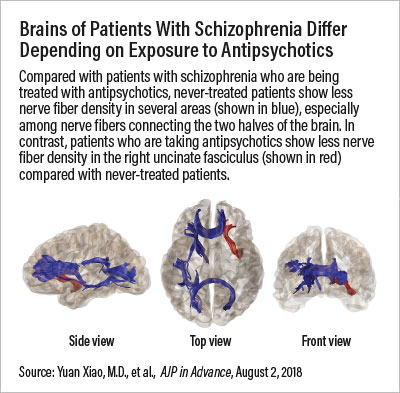Neuroimaging studies over the years have suggested that the brains of patients with schizophrenia deteriorate more rapidly with age than those of others. What has been less clear to researchers is the degree to which this deterioration is influenced by chronic illness versus long-term use of antipsychotics.
“Every time you use these medications you are changing the chemistry and biology of the brain,” said John Sweeney, Ph.D., a professor of psychiatry at the University of Cincinnati. “But how can you quantify these changes?”
A study published August 2 in AJP in Advance has provided the first glimpse of how illness and medications distinctly contribute to brain changes over time. Sweeney and colleagues at Chengdu’s West China Hospital of Sichuan University analyzed brain scans of people with schizophrenia who were or were not exposed to antipsychotics. They found evidence to suggest that prolonged antipsychotic use is not deleterious to the brain; in fact, antipsychotics may protect the brain over time.
The investigators compared MRI scans collected from 31 patients with long-term schizophrenia (at least five years) who never received antipsychotic treatment (“never-treated”) with those of 46 patients who had received long-term antipsychotic treatment (“treated”) and 58 controls without schizophrenia.
The scans showed that the never-treated patients with schizophrenia had a reduced density of white matter—the insulated nerve fibers that crisscross the brain to connect different regions—compared with patients in the treated group. Both groups had reduced white-matter density compared with control participants.
The reduced density of white matter was evident in regions across the brain but was concentrated around the frontal cortex. One exception was seen in the tract of nerve fibers connecting the frontal cortex to the amygdala and hippocampus, which showed greater density in never-treated patients than in the treated patients. This tract of nerve fibers, known as the right uncinate fasciculus, is important for processing emotions.
Sweeney told Psychiatric News that the reduced density of these nerve fibers in patients taking antipsychotics might explain the low affect (emotional numbness) reported by some patients taking antipsychotics; however, he cautioned that this is just a hypothesis at this point.
For most of the observed differences in white matter density in patients with schizophrenia, the researchers identified no connections between severity of white matter loss and patient age or illness duration. Since all study participants had schizophrenia for at least five years, this suggests that the changes likely occur early in the course of the illness.
In contrast, older patients in the never-treated group had lower white matter density in the front part of corpus callosum (the thick band of nerves that runs lengthwise across the brain and connects the two halves) than younger ones. Patients treated with antipsychotic medications, however, showed a relatively stable corpus callosum density at all ages.
Interestingly, treated patients aged 40 and younger had lower corpus callosum density compared with never-treated individuals at similar ages. This observation suggests that antipsychotic treatment may produce some adverse short-term changes in the brain, but then helps preserve white matter microstructure over time, the authors wrote. Whether this preservation is a direct pharmacological effect, or the indirect result of more stable psychosis symptoms, is yet to be determined, they continued.
Sweeney said that this study highlights the value of partnering with developing countries to study the natural progression of mental illness. These countries have many rural areas where finances, lack of access, and/or family stigma contribute to a sizeable population of psychiatric patients never receiving medications. The governments of these countries have been expanding their efforts to identify and treat these patients, which provides research opportunities, he said.
This study was supported in part by the National Natural Science Foundation of China. ■
An abstract of “White Matter Abnormalities in Never-Treated Patients With Long-Term Schizophrenia” can be accessed
here.

